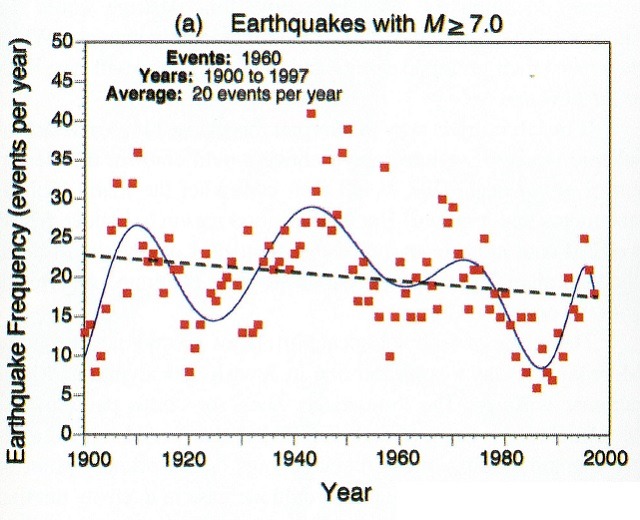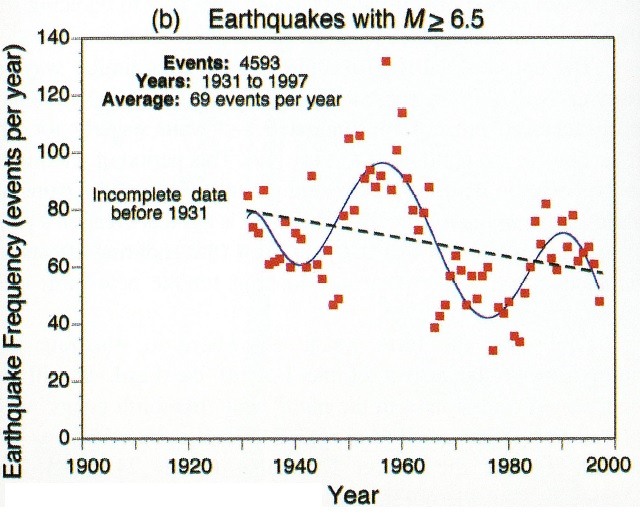This article first appeared in the Christian Research Journal volume 21, number 4 (1999). For further information or to subscribe to the Christian Research Journal go to: www.equip.org.
SUMMARY
Has an unusual increase in the frequency of big earthquakes afflicted civilizations in the last decades of the twentieth century? Is the supposed global increase in big earthquakes a fulfillment of prophetic statements concerning the “end of the age” made by Jesus? Contrary to the opinions of many prophecy teachers, global and regional earthquake data argue that big earthquakes have been decreasing in frequency through the twentieth century. Moreover, no clear scriptural warrant exists for the notion that earthquakes will increase in frequency just before the tribulation period and the return of Christ. Earthquakes of the present “church age” serve as reminders of creation’s present pain. A future cosmic shakedown will give birth suddenly to “a kingdom that cannot be shaken.”
According to a number of Christian writers and teachers on Bible prophecy, Jesus predicted in the Olivet Discourse that a pronounced increase in the frequency and intensity of earthquakes would occur just prior to His return to earth. Many of the same writers and teachers claim that the 1990s have experienced a pronounced increase in both the frequency and intensity of earthquakes as compared to earlier decades of the twentieth century. This supposed coincidence of Jesus’ prophetic statement and recent seismic events is seen as a clear indication of the nearness of Christ’s return.
PROPHECY TEACHERS ON EARTHQUAKE
Hal Lindsey, the world’s best-known Bible prophecy teacher, writes in one of his latest books: “Earthquakes continue to increase in frequency and intensity, just as the Bible predict for the last days before the return of Christ. History shows that the number of killer quakes remain fairly constant until the 1950s—averaging between two to four per decade. In the 1950s, there were nine. In the 1960s, there were 13. In the 1970s there were 51. In the 1980s there were 86. From 1990 through 1996, there have been more than 150.”1
Lindsey first published such statistics in 1994 as a list in the first edition of his book Planet Earth 2000 A.D., and he defined “killer quakes” as being magnitude 6.0 and greater.2 What is the source of Lindsey’s statistics? He cites the United States Geological Survey (USGS) in Boulder, Colorado, but he does not give details of the report (report name, author, date, location, etc.).3
Grant R. Jeffery, another Bible prophecy teacher, cites similar earthquake statistics. In 1994, the same year Lindsey began publishing his statistics, Jeffery wrote:
However, since A.D. 1900, the growth in major earthquakes has been relentless. From 1900 to 1949 it averaged three major quakes per decade. From 1949 the increase became awesome with 9 killer quakes in the 1950’s; 13 in the 60’s; 56 in the 1970’s and an amazing 74 major quakes in the 1980’s. Finally, in the 1990’s as [sic] the present rate, we will experience 125 major killer quakes in this decade (source U.S. Geological Survey Earthquake Report,, Boulder, Colorado).4
The statistics of Lindsey and Jeffery differ slightly, making it possible to distinguish whose numbers are being cited by later authors. Lindsey’s earthquake-frequency numbers have been widely circulated by popular prophecy speakers such as Chuck Missler, Jack Van Impe, Randal Ross, and Gary Stearman.5 Tim LaHaye, however, uses Jeffery’s statistics.6 These authors do not give any further information on the source of Lindsey’s or Jeffery’s statistics.
John Hagee references a report from the National Earthquake Information Center of the U.S. Geological Survey that “the number of large earthquakes (magnitude 6.0 or greater) have stayed relatively constant…” and that “the last decade has produced substantially fewer large earthquakes than shown in the long-term averages….”7 Remarkably, Hagee goes on to directly contradict the government report: “It is true that the Bible predicts that earthquakes will increase in the last days, and the number of earthquakes measured has increased 1.58 times between 1983 and 1992” (emphasis in original).8
A different set of earthquake frequency numbers appears in the recent writings of Peter and Paul Lalonde:
Well, according to the sources from Energy, Mines and Resources Canada there were, from 1900 to 1969, about 48 earthquakes that registered at 6.5 or more on the Richter Scale. This is an average of 6 per decade. From 1970 to 1989 there were 33 earthquakes measuring 6.5 or more. This is an average of 17 per decade. From January 1990 to October 1992 there were 133 earthquakes which measured at 6.5 or greater. This averages out to 600 per decade.9
What is the specific source within Energy, Mines and Resources Canada that supplied these statistics? Again, details are lacking.
In light of such slipshod documentation, we are concerned about the wide spread claim within the Christian community that earthquakes are on the increase. Has the deployment of more seismographs during the past few decades made detection and cataloging of earthquakes more complete, thereby allowing for the perception of increase? Is the public perception further enhanced by the fact that earthquakes now strike larger urbanized populations, and therefore are more often reported by the news media? We believe these factors contribute to a self-sustaining “urban legend” especially embraced by Christians.
GLOBAL EARTHQUAKE DATA
The year 1997 marked the one hundredth anniversary of the general deployment of standardized and calibrated seismographs. It started with nine seismograph stations in 1898, which were capable of detecting, locating, and measuring earthquakes of magnitude 7.0 or larger anywhere on the planet. By 1931 there were 350 stations operating worldwide that were locating and measuring magnitude 6.5 and greater earthquakes globally. By the 1950s the system of seismographs could locate all magnitude 6.0 and greater events occurring worldwide. Earthquakes of magnitude 5.0 and greater were being located globally by the 1970s. Today a network of more than 4,000 seismograph stations is locating and measuring more than 17,000 events yearly, about 16,000 of these have magnitude less than 5.0.
Global earthquake data for the century have been synthesized and are available from several sources. We recommend two global standards for accuracy, completeness, and uniformity.
1. The Zirbes Data File. The National Earthquake Information Center (NEIC) of the United States Geological Survey (USGS) in Denver maintains data on four million earthquakes.10 The summary data file currently updated yearly by Madaleine Zirbes of the NEIC include global frequency data for magnitude 7.0 and larger earthquakes since 1900.11
2. The “Seismicity Catalog.” The National Geophysical Data Center (NGDC) of the National Oceanographic and Atmospheric Administration (NOAA) distributes numerous data files within the “Seismicity Catalog.”12 The catalog’s component data file, called “1900.EQ,” gives time, location, and magnitude for 17,690 magnitude 6.0 and greater earthquakes (5,667 if these are magnitude 6.5 and greater) globally from 1900 through 1995.
THE GEOLOGICAL EVIDENCE: ARE EARTHQUAKES INCREASING?
If the notion of prophecy teachers is correct, two assertions about twentieth-century earthquakes must be true:
- a comparative infrequency of big earthquakes occurred in the first half of the century, and
- an obvious increase in the frequency of big earthquakes occurred since 1950.
Prophecy teachers must make these two assertions to support the notion that the “earthquake sign” is occurring in the 1995s. Both assertions, we maintain, are false. Using the best earthquake catalog data and statements of seismologists, we have concluded exactly the opposite:
- a comparative excess of big earthquakes occurred in the first half of the century, and
- an obvious decrease in the frequency of big earthquakes occurred since 1950.
Global Earthquake Frequency. The frequency of this century’s biggest earthquakes is summarized in Figure 1. The frequency of the biggest earthquakes (magnitude 7.0 and greater) by year 1900 through 1997 is shown in Figure 1a, which magnitude 7.0 and greater earthquakes per year. Fig. 1b shows the frequency of magnitude 6.5 and greater earthquakes beginning in the year 1931 when the seismograph detection system became established well enough to record a “globally complete” set of these larger events. Figure 1b displays a total of 4,593 earthquakes, an average of 69 magnitude 6.5 and greater events per year.
Line and curves are also plotted to the data in Figure 1. In both of the plots the best-fit linear equations have negative slope indicating an overall decreasing, not increasing, frequency with time. The noteworthy excess of big earthquakes (magnitude 7.0 and greater) in the first half of the twentieth century is opposite to the statements of many prophecy teachers. In addition, a noteworthy decrease in the frequency of big earthquakes (magnitude 7.0 and greater) since 1950 conflicts with the assertion of the same prophecy teachers.

Figure 1. Global frequency of the largest earthquakes during the twentieth century. In both plots a general decrease in earthquake frequency is evident throughout the twentieth century. Graph (a) shows the frequency of magnitude 7.0 and greater earthquakes during the entire century (source: NEIC “Zirbes data file”).

Figure 1b. Graph (b) shows the frequency of magnitude 6.5 and greater earthquakes after 1930 (source: NGDC data file “1900.EQ”
Hal Lindsey is aware of the Zirbes Data File and the evidence from the USGS, which says magnitude 7.0 and greater earthquakes are not increasing in our century. His response is: “The USGS traditionally defined a major earthquake as being ‘6.5 magnitude or greater, and causing significant death or damage.’ That is still the category heading used when they compile their own statistics. By the simple expedient of raising the minimum magnitude level for the basic criteria [to 7.0], earthquakes statistics can be manipulated to support their contention of no increase in major earthquakes.”13
Is the USGS “selectively manipulating”14 its magnitude criteria (7.0 and greater instead of 6.5 and greater) in order to conceal the increase in frequency as asserted by Lindsey? His claim of malpractice or deception by seismologists is easily refuted by going to the magnitude 6.5 and greater frequency plot in Figure 1b. The frequency plot is where the obvious increase of the 1980s and 1990s should be most apparent, according to Linsey, but we see that Figure 1b (from “1900.EQ”) has general declining frequency like Figure 1a. The best-fit linear equations shown by dashed lines possessing negative slopes in Figure 1a and 1b indicate the declining frequency. No evidence of pronounced frequency increase is evident for the 1980s and 1990s.
Regional Earthquake Frequency. Lindsey writes of increasing earthquake frequency recently in California, Japan, and the Middle East.15 Regional earthquake catalogs should show the recent increase if Lindsey’s claim is correct. Seismologist L.K. Hutton and L.M Jones performed a detailed study of magnitude 5.0 and greater events since 1932 in Southern California and found no significant region-wide rate change, including the period after 1980.16 R. Stein and T. Hanks constructed their “Southern California Catalog,” which is complete for magnitude 6.0 and greater earthquakes from 1903 through 1997.17 They say of Southern California, “We find no evidence that the rate of seismicity is increasing, now or at any other time since 1900.”18 Their findings contradiction both Lindsey’s statistics and conclusions.
As the world’s most seismically active region, Japan should have an interesting story to tell. Does it show a recent increase, as the urban legend supposes? Y. Ogata and K. Abe, two Japanese seismologist, compared earthquake frequency variation within a 95-year period between the entire world and the region of Japan. They wrote, “The occurrence rate of earthquakes in the two areas is high in the period of 1920’s through 1940’s and low in the last 30 years.”19
The Eastern Mediterranean region and the Middle East, because of their importance in Bible prophecy, might show an increasing frequency trend in our century. Yet, a noteworthy and continuing decline of earthquakes is apparent there as well. Seismologist N.N. Ambraseys writes: “Most certainly, there has been no increase in the seismic activity of the Mediterranean the activity of this century has been abnormally low when compared with that of the 10th-12th and 18th centuries.”20
Are “Killer Quakes” on the Increase? Global and regional data show that the geographic distribution of earthquakes has not significantly changed in our century. Could the depths of earthquakes changed in recent decades? It is a well-known fact that earthquakes occur by rupture along fault surfaces at differing depths within the earth. Some earthquakes occur or rupture surfaces up to 800 kilometers (500 miles) below the earth’s surface. Because of their distance from the earth’s surface, the deeper earthquakes do not cause significant damage or deaths in human population. Shallow earthquakes (depths of less than 70 kilometers) cause the largest number of deaths and the most sever property damage. Could the recent decades of this century have experienced more shallow earthquakes than previous decades? Could the rise in frequency of such shallow “killer quakes” be a sign to our generation?
Figure 2 shows magnitude 5.0 and greater earthquakes for the period of 1977 through 1998 from NEC database.21 This magnitude range, of course, includes all “killer quakes.” Figure 2 color-codes the depth of each earthquake. No significant increase in the frequency or intensity of shallow “killer quakes” (yellow and orange circles) is apparent since 1977 from the data of Figure 2. Also no significant decrease in the deepest “non-killer” earthquakes (red and purple circles) is evident in 1977.

Figure 2. Magnitudes and depths of larger earthquakes globally since 1977. The graph includes magnitude 5.0 and larger earthquakes globally. The frequency of these larger earthquakes has been uniform since 1977. Large, shallow earthquakes that cause significant death and destruction (“killer quakes”) are depicted by orange and yellow circles. No significant increase in frequency of “killer quakes” is evident since 1977. (Source: NEIC of the U.S. Geological Survey.)
Historical data disputes the whole idea that “killer quakes” are on the increase. Johnson and Herbst compared earthquake death estimates from equivalent decades of the eighteenth century to the twentieth century.22 For the period 1715 through 1786, they estimated 1.37 million deaths globally, but only 1.21 million deaths from 1915 through 1983. Earthquake deaths are on the decrease, even though there has been a six-fold increase in world population since the eighteenth century.
THE BIBLICAL EVIDENCE:
DID JESUS PREDICT AN INCREASE IN EARTHQUAKES BEFORE THE END?
If earthquakes are not on the increase, then what shall we make of the biblical evidence? Does this mean that the return of Christ cannot be near? Closer examination of the New Testament evidence will reveal that the prophecy teachers are wrong on this count as well. Not only are earthquakes not increasing, but also the biblical text never indicated they would.
Earthquakes in Biblical Literature. Earthquakes and other cataclysmic events often carry theophanic (God-manifesting) significance in Scripture, demonstrating God’s awesome power. Many seismic theophanies are manifestations of God’s anger and righteous judgment (cf. 1 Sam. 14:15; Ps. 18:7-8; Isa. 5:25; 13:13; 29:6; Joel 3:16; Amos 1:1-2; 8:7-8; Mic. 1:3-7; Nah. 1:5-6; Hag. 2:6, 21).
The most elaborate judgment motif in Scripture is the Day of the Lord. Without faith that day is marked by earthquakes and associated celestial disturbances (Isa. 2:19, 21; 13:13; 24:18; 29:5-6; Ezek. 38:19-22; Joel 2:10; Zech 14:4-5). When the armies of Gog attack Israel, those armies are demolished at the decree of the Lord by earthquake and hailstones (Ezek. 38:17-23). Zechariah is even more explicit about the extraordinary geologic upheaval in the Holy Land associated with the Day of the Lord. A final earthquake will split the Mount of Olives, uplift Jerusalem on its site, and depress the surrounding Judean Mountains (Zech. 14:1-10).
Earthquakes are also associated with God’s self-revelation in the eschatology of the Book of Hebrews (12:25-29). The author warned his readers to heed the God who spoke at Sinai (“And His voice shook the earth then,” Heb. 12:26; cf. Exod. 19:18).23 The author then passes through the history from Sinai to the end times and the promise of a great cosmic upheaval (“yet once more I will shake not only the earth, but also the heaven,” Heb. 12:16; cf. Hag. 2:6). God’s ultimate purpose is to give believers “a kingdom which cannot be shaken” (Heb. 12:28).
Such passages provide the eschatological backdrop for the Book of Revelation, where earthquakes are symbols of God’s final judgment upon the earth. Five earthquakes (Greek: seismos) are described (Rev. 6:12; 8:5; 11:13, 19; 16:18), splitting Jerusalem into three parts and destroying the cities of the nations.
While demonstrating the awesome power and presence of God, these passages do not indicate an increase in earthquakes in the present age. For those of us who follow a futuristic and dispensational interpretation of Revelation, these earthquakes occur during the Great Tribulation, not before it. They are no precursors to the Day of the Lord but evidence of its presence.
The Olivet Discourse. The Olivet Discourse is set in the context of Jesus’ statement concerning the destruction of Jerusalem (Matt. 24:1) and the disciples’ question, “Tell us, when will these things be, and what will be the sign of Your coming, and the end of the age?” (v. 3). Our primary concern is with the first part of the discourse.24 Here Jesus warned against being deceived by false christs or being alarmed at wars, rumors of wars, famines, and earthquakes:
And Jesus answered and said to them, “See to it that no one misleads you. For many will come in My name, saying, ‘I am the Christ,’ and will mislead many. And you will be hearing of wars and rumors of wars; see that you are not frightened, for those things must take place, but that is not yet the end. For nation will rise against nation, and kingdom against kingdom, and in various places there will be famines and earthquakes. But all these things are merely the beginning of birth-pangs” (Matt. 24:4-8).
Among dispensationalists there are two interpretations of these verses:
1. Some dispensationalist (and other futurists) see the whole of the Olivet discourse as relating to the tribulation of the first half of the tribulation period while verses 9-26 concern the second half—the Great Tribulation.25 Evidence for this is claimed in the similarity between the events described in verses 4-8 and those associated with the seven seals of Revelation 6.26 For advocates of this view, the earthquakes identified in verses 7-8 are not part of the present church age but rather the tribulation period. In this case, even if the birth image in verse 8 were to indicate an increase in earthquakes (which is not necessary; see discussion below), this increase occurs during the tribulation, not during the present church age. Present data concerning earthquake frequency has little or no bearing on the text.
2. Other dispensationalists (and almost all non-dispensationalists) claim that verses 4-8 (or vv. 4-14) concern not the tribulation period, but general signs that are characteristic of the present age. Lewis Sperry Chafer wrote that the events described in verses 4-8 “are the characteristics of the unforeseen intervening or intercalary age”27—that is, the church age. John Walvoord similarly affirms that “verses 4-14 are general prophecies that can find fulfillment throughout the present age, with verses 15-30 fulfilled in the Great Tribulation.”28 He adds, however, that these former events “are repeated in the Great Tribulation when what was perhaps partially fulfilled earlier then have an very literal and devastating fulfillment.”29 The primary evidence that verses 4-14 are signs characteristic of the present age are their general nature and the fact that Jesus identified them as events that do not indicate the end (“but that is not yet the end”) and so should not provoke apocalyptic fervor (“see that you are not alarmed”).
In this latter view, therefore, Jesus warned His disciples against mistaking catastrophic events in human history with the cataclysmic events that will characterize the End. Dispensational writers who take verses 4-14 as part of the present age recognize this qualitative difference between the “general signs” of verses 4-14 and the “specific signs” that follow in verses 15-26. John Walvoord writes,
Taken as a whole, the opening section, ending with Matthew 24:14, itemizes general signs, events, and situations which mark the progress of the age, and, with growing intensity, indicating that the end of the age is approaching. These signs, however, by their very characteristics are because they have occurred throughout the present age, do not constitute a direct answer to the question of “the sign” of the coming of the Lord.30
While Walvoord affirms that these are events common to the present age and that they, therefore, do not constitute the answer to the disciples’ question (“what will be the sign of your coming?”), he jumps to the unwarranted conclusion that these “general signs” will increase with intensity as the end of the age approaches. Jesus did not indicate such an increase. He downplayed their significance and encouraged His followers not to be alarmed or disturbed by them. He certainly did not say to count their frequency and calculate the end.
Eschatological Birth Pains. The only statement that might suggest an increase in famine and earthquake activity is the final clause, “But these things are merely the beginning of the birth pangs (oidines)” (Matt. 24:8). Because birth pains begin small and then increase in intensity and frequency, this passage could be interpreted to mean that earthquakes will gradually increase. When they reach their greatest severity and frequency, they will give birth to the new age.
Is this the correct way to interpret this clause? If so, the lack of seismic increase we have noted above would confirm that Jesus’ return is not near. This would then contradict the many biblical statements that it is near! But there is good reason to believe Jesus’ words do not indicate an increase in frequency or severity of these “general signs,” but they only indicate their continued recurrence until the end of the age.
The image of eschatological birth pains was not new to Jesus. Moreover, it was a common one in Jewish apocalyptic and later rabbinic writings. The “messianic woes” or “birth pains of the Messiah” referred to a period of suffering that would immediately precede the coming of the messianic age.31 The primary point of the image was not that the pain would increase in intensity but that the joy of new birth (i.e. salvation and restoration) would follow the present period of suffering. Pain will give way to rejoicing for those who persevere.
The apostle Paul used the birth image in a similar way in Romans 8:18-25. The present creation—for which salvation has been achieved but not consummated—“waits eagerly for the revealing” of the children of God (v. 19). This period of waiting is metaphorically described as groaning and suffering “the pains of child-birth (sunodino)” (v. 22). The point is not that creation’s pain is growing worse but that the pain itself (the enduring effects of humanity’s fall) provokes eager longing for the new birth (the consummation of salvation).
Paul used the birth image elsewhere to illustrate the abruptness of the arrival of the Day of the Lord. It will be unexpected “like a thief in the night” and “like birth pangs” of a pregnant woman (1 Thess. 5:2-3). Paul’s two images are reminiscent of the Olivet Discourse (Matt. 24:8, 43-44). Obviously, Paul was not saying here that we can predict our Lord’s appearance by noting precursor birth pains.
WHAT WE’VE LEARNED
A number of prophecy teachers say that a pronounced increase in frequency and intensity of earthquakes has occurred in the latter part of the twentieth century—a worldwide trend fulfilling a prophecy made by Jesus. Yet, no obvious trend is found to indicate an abnormal increase in the frequency of large earthquakes during the last half of the twentieth century. Neither was there a relative infrequency of earthquakes in the first half of the century. Graphical plots of global earthquake frequency indicate overall a decreasing frequency of earthquakes.
The decades of the seventies, eighties, and nineties experienced a decrease of larger earthquakes compared to earlier decades of the twentieth century. The seventies, eighties, and nineties are precisely those decades that many prophecy teachers erroneously suppose show a dramatic surplus of larger earthquakes. Regional earthquake data also do not argue for increasing earthquake frequency in California, Japan, and the Eastern Mediterranean during the final decades of our century. “Killer quakes” do not appear to be increasing globally in the same decades, and earthquake deaths in the twentieth century do not significantly exceed earthquake deaths of earlier centuries.
At the time of Christ, the Jews had a heightened understanding of wars, famines, pestilence, and earthquakes as signs having apocalyptic significance. Jesus responded to apocalyptic expectations in His Olivet discourse. Whether one interprets Matthew 24:4-14 as (1) events that will occur during the tribulation period or (2) general signs of the present age, there is no clear scriptural warrant for the claim that earthquakes will increase dramatically prior to Christ’s return. In the former interpretation, these earthquakes would be part of the tribulation period and of little significance for any increase in earthquakes during the present church age. In the latter interpretation, earthquakes are seen as recurring catastrophic events common to the present age—events that must not be misinterpreted as “sings” of an immediate end. It is ironic that a passage that intentionally teaches that earthquakes are not indicators of the “end of the age” should be frequently interpreted as teaching the exact opposite.
Jesus’ statement “all these things are merely the beginning of birth-pangs” (Matt. 24:8), has been misunderstood to imply that pain would increase steadily in time. The birth image associated with such signs does not point to an increase in pain with time. Paul’s understanding of creation’s pain (Rom. 8:18-25) is not that pain will grow steadily worse but that the present period of suffering provokes eager longing for the new birth and the consummation of the coming age. The author of Hebrews offered a similar hope, not in anticipating a future “sign” of increasing earthquake activity, but in the coming of a sudden cosmic cataclysm producing a “kingdom which cannot be shaken” (Heb. 12:28).
Steve A. Austin, Ph.D., is Chairman of the Geology Department at the Institute for Creation Research in Santee, California.
Mark L. Strauss, Ph.D., is Associate Professor of New Testament at Bethel Seminary San Diego
Notes:
- Hal Lindsey, Apocalypse Code (Palos Verdes, CA: Western Front Ltd., 1997), 296. Lindsey has been writing about the twentieth-century increase of earthquakes for almost 30 years. See his book The Late Great Planet Earth (Grand Rapids: Zondervan, 1970), 52, which sold over 20 million copies.
- Hal Lindsey, Planet Earth 2000 A.D.., 1st ed. (Palos Verdes, CA: Western Front Ltd., 1994), 83.
- Ibid., 84. Lindsey’s citation is suspicious. Though he claims to be using a USGS source, his endnote (100) refers only to the Los Angeles Herald Examiner, 22 May 1984. One wonders how a newspaper published an early in 1984 could provide data for an increase in earthquakes in the 1980s and 1990s.
- Grant Jeffery, Prince of Darkness (Toronto: Frontier Research Publications, 1994), 310-11. Jeffery gives no information on how a copy of this report can be obtained (author, date, report name, and location). See repeated statistics in Jeffery, The Signature of God (Toronto: Frontier Research Publications, 1996), 194, and Armageddon: Appointment with Destiny, rev. ed.(Toronto: Frontier Research Publications, 1997), 251-252.
- Chuck Missler and Mark Eastman, Alien Encounters (Coeur d’ Alene, ID: Koinonia House, 1997), 170-72, Jack Van Impe, “News about Natural Phenomena, Killer Earthquakes on the Rise,” Intelligence Briefing at Web site: www.jvim.com/IntelligenceBriefing/May 1997/nature.html, Randal Ross, The Next 7 Great Events of the Future (Orlando, FL: Creation House, 1997), 11, Gary Stearman, “Are Earthquakes on the Increase?” Prophecy in the News 16 (June 1996): 3-5. Gary Stearman, “Earthquakes Are Indeed on the Increase,” Prophecy in the News 16 (October 1996): 27-28. Stearman cites as his source the 11 October 1995 issue of the newspaper Philadelphia Inquirer. Computer-searchable archives of the Philadelphia Inquirer, however, reveal no article on earthquake frequency in the newspaper on 11 October 1995.
- “Tim LaHaye, “The Signs of the Times Imply His Coming,” in John Van Diest, ed. Ten Reasons Why Jesus Is Coming Soon (Sisters, OR: Multnomah Books, 1998), 206.
- John Hagee, Beginning of the End (Nashville: Thomas Nelson, 1996), 193.
- Hage, 193. Hagee’s citation of numbers allows us to understand how he has misquoted the government report. Hagee, 98, says: “The number of earthquakes recorded has risen from 2,588 in 1983 to 4,084 in 1992.” Here Hagee has committed a serious error by citing the “No Magnitude” row in the National Earthquake Information Center (NEIC) worldwide seismic frequency table. Thanks to significant improvement in the seismograph network, the NEIC locates now four times as many earthquakes as it did 30 years ago. Detection of earthquakes is greatly improved in the below magnitude 5.0 category. Charles Capps in End-time Events—Journey to the End of the Age (Tulsa: Harrison House, 1997) errs by citing the much increased lower-magnitude data: “A recent U.S.G.S. report shows there were 4,139 earthquakes in 1970—and 19,996 in 1996.” Capps concludes incorrectly, “Earthquakes are definitely on the increase” (13).
- Peter Lalonde and Paul Lalonde, 301 Startling Proofs and Prophecies (Niagra Falls, ONT: Prophecy Partners, 1996), 248. The Lalonde earthquake frequency numbers have been widely quoted by pupar authors Daymond R. Duck, Revelation: God’s Word for the Biblically-Inept (Lancaster, PA: Starburst Publishers, 1998), 242, and Jack Van Impe, “Last Days: Hype or Hope?” Perhaps Today, September-October 1996, viewed on 20 August 1998 on the Internet at: http://www.jvm.com/PerhapsToday/SepOct1996/last.html. Apocalyptic increase of earthquakes in the 1990s is reported by David Allen Lewis (Signs of His Coming [Green Forest, AR: New Leaf Press, 1997], 24): “There have been more earthquakes in the last 50 years than in the previous Earthquakes, as Man Rebels,” in Bob Anderson, et al., Earth’s Final Days [Green Forest AR: New Leaf Press, 1995], 68, says, “In this century, there have been more earthquakes than all the rest of history put together…. Every 10 years, earthquakes double in number, and so it has been for the last 10 decades. During the later part of this decade, earthquakes will occur with increasing regularity, creating terror and panic throughout the world. Jesus said that this was one of the signs of His coming.” If earthquakes are incrasing so rapidly in the 1990s, then what is there to prevent Christ’s return? Therefore, in Larry Wilson, The Revelation of Jesus (Brushton, NY: Teach Services,1992), 1, we find the former Seventh-day Adventist pastor predicting four global earthquake beginning about 1994 and ending in 1998 with the Second Coming of Christ. Hugh Ross, who holds a Ph.D. in the physical science, argues for a recent exponential increase in the number of casualty-causing earthquakes. We viewed his “Signs of the End” on 10 May 1999 at: www.reasons.org/resources/papers/endsigns.html.
- The NEIC Internet home page is http://wwwneic.cr.usgs.gove.
- The Internet location http://www.neic.cr.usgs.gove/neis/eqlist/7up.html contains the summary data listing.
- National Oceanic & Atmospheric Administration, Seismicity Catalog (Boulder, CO: National Geophysical Data Center, 1996), two volumes on CD-ROM disks. See “Worldwide Earthquake Database” and its Seismicity Catalog on the Internet at http:www.ngdc.noaa.gov/seg/hazard/earthqk.html.
- Lindsey, Planet Earth 2000 A.D., 2nd ed., 88. The first edition of Planet Earth does not contain this statement. Evidently Lindsey needed to expand the second edition to answer his critics.
- Ibid., 89.
- Ibid., 85-86
- L.K. Hutton and L.M. Jones, “Local Magnitudes and Apparent Variations in Seismicity Rates in Southern California, Bulletin of the Seismological Society of America 83 (1993): 313-29.
- R. Stein and T. Hanks, “M > 6.0 Earthquakes in Southern California during the Twentieth Century: No Evidence for a Seismicity or Moment Deficit,” Bulletin of the Seismological Society of America 88 (1998): 635-52. See Intenet at: http://quake.wr.usgs.gove/study/deformation.
- Ibid., 635.
- Y. Ogata and K. Abe, “Some Stastical Features of the Activity,” International Statistical Review, 59 (1991): 139.
- Letter dated 9 August 1985 from N.A. Ambraseys, reproduced in Carl O. Johnsson and Wolfgang Herbst, The Sign of the Last Days—When? (Atlanta: Commentary Press, 1987), 244.
- The graph summarizes the NEIC database known as the “Preliminary Determination of Epicenters” (PDE). The graph was downloaded 9 March 1999 from the NEIC web site: http:www.neic.cr.usgs.gov/neis/eqlists/graphs.html.
- Jonsson and Herbst, 78-84
- Scripture quotations are from the New American Standard Bible.
- For summaries of the various views see D.A. Carson, “Matthew,” in The Expositor’s Bible Commentary, vol. 8, Frank E. Gaebelein, ed. (Grand Rapids: Zondervan, 1984), 491-95; J. Dwight Pentecost, Things to Come: A Study of Biblical Eschatology (Grand Rapids: Zondervan, 1964), 277-78.
- See Pentecost, 278-79; idem, Thy Kingdom Come “Mathew,” in The Bible Knowledge Commentary: New Testament, J. Walvoord and R. Zuck, eds. (Wheaton, IL: Voctor, 1983), 76-77. A modification of this interpretation extends the first half of the tribulation to verse 14.
- See Pentecost, Things to Come, 278-79.
- L.S. Chafer, Systematic Theology (Dallas: Dallas Seminary Press, 1948), 120.
- J. Walvoord, The Bible Knowledge Handbook (Wheaton, IL: Victor, 1990), 381. While Walvoord is here describing various views (not identifying his own), this view is also expressed in his commentary, Matthew: Thy Kingdom Come (Chicago: Moody, 1974), 1984.
- Walvoord, Bible Knowledge Handbook, 382-83.
- Walvoord, Matthew, 184.
- For references see G. Bertram, Theological Dictionary of the New Testament, vol. 9, G. Friedrich, ed., G.W. Bromiley, tr. and ed. (Grand Rapids: Eeerdmans, 1974), 670 ff.; Donald A. Hagner, Matthew 14-28, Word Biblical Commentary, 33B (Dallas: Word, 1995), 691.








